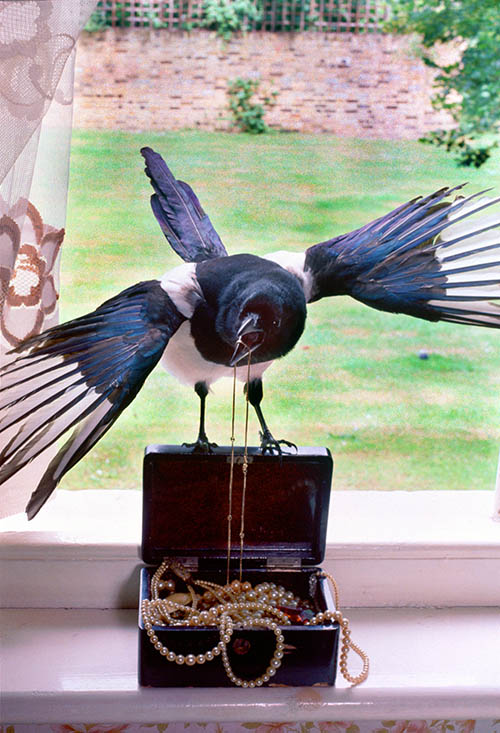Curious Questions: One for sorrow, two for joy – but why are we so superstitious about magpies?
Superstitions swirl around all manner of different birds, but never more so than with magpies. We take a look at why.


One for sorrow, Two for joy, Three for a girl, Four for a boy, Five for silver, Six for gold, Seven for a story yet to be told.
We've all grown up with the magpie rhyme. Most of us have (or had) grandmothers who shudder upon seeing a solitary magpie, immediately scanning the sky for another that will allow them to swap sorrow for joy. Some people even call out to single magpies: ‘Hello, Jack – how’s your brother?’ or ‘Hello, Mr Magpie – how’s your wife today?’
The One for sorrow rhyme is just the start of the superstitions and old wives' tales that surround the bird. But what is it about them which provokes such a reaction?
After all, these are no birds or prey or great grey shrikes with their bloodthirsty tastes; instead, they are handsome, highly intelligent birds.
Ian Morton tried to unravel the question in a recent edition of Country Life. 'Magpies have a longstanding place in the annals of superstition,' he wrote.
'Early Christians saw the bird as a symbol of dissipation and vanity, holding it cursed among the crow tribe for not wearing completely black plumage in mourning after the Crucifixion.
'Among devout Scots, it was considered so evil that each bird was believed to carry a drop of the Devil’s blood under its tongue. In Somerset, country folk carried an onion as protection against the influence of crows and magpies and tipped their hats in salute if they encountered them.
Exquisite houses, the beauty of Nature, and how to get the most from your life, straight to your inbox.
'English people generally were prone to cross themselves and raise their hats upon seeing magpies, intoning as they did so: "Devil, Devil, I defy thee!"'
'In France, evil priests were thought to be reincarnated as crows and evil nuns as magpies. Ten sub-species are spread worldwide and, among the Blackfoot Indians of North America, the magpie held shamanic qualities involved in the origins of the Buffalo Dance.'
Lying behind the reputation is probably the magpie's somewhat bloodthirsty actions: they’re famed for predating smaller birds’ eggs and chicks, especially those of songbirds. Recent research by the British Trust for Ornithology suggests that they have little (if any) impact on songbird populations yet it's not hard to see how stealing eggs (and jewellery) earned the bird a reputation for skulduggery.

Yet while its image is dark in Europe and America, in the Far East it enjoys a rather different status. 'In China it presaged joy and good fortune, its staccato voice a prelude to the arrival of good news and welcome guests,' writes Ian Morton. 'In Korea, too, the magpie was the bringer of good news and good people.'
And even on these shores things haven't always been quite so – if you'll forgive the pun – black and white. The bird possesses great intelligence, due in part to the fact that it is anything but bird-brained: its nidopallium-to-bodymass ratio is said to be similar to that of chimps, orangutans and even humans.
A 19th century gamekeeper and naturalist called Tom Speedy killed hundreds of magpies when he caught them predating pheasants' nests, but still admitted his admiration for the birds:
‘The magpie is one of the most expert, genteel and well-dressed of thieves,’ wrote Speedy.
‘Few British birds possess such a rich glow of colour, the brilliancy of the plumage on the tail and wings being of metallic splendour, the bird being gay alike in nature and plumage.’

The Speedy generation hit the magpie hard. The species was common and plentiful until the middle of the 19th century and popular with farmers because of its predation of insects and rodents. However, the development of game-rearing and shooting made it the bane of keepers’ lives. Numbers were severely reduced and only started to recover after the Second World War. They trebled between 1970 and 1990 and are now considered steady.
It’s widely supposed that the number of magpies seen together indicates good or bad luck, but not all versions of the familiar rhyme agree. In fact, some even contradict others. Mr Morton collected the versions told in his family, the Oxford Dictionary of Superstitions, the Scottish as quoted by Tom Speedy and the Scottish in Brewer’s Dictionary of Phrase and Fable:
- Morton Family lore: One for sorrow, Two for joy, Three for a girl, Four for a boy, Five for silver, Six for gold, Seven for a story, Yet to be told
- Oxford: One for sorrow, Two for mirth, Three for a wedding, Four for a birth, Five for rich, Six for poor, Seven for a witch, I can tell you no more
- Speedy: One’s sorrow, Two’s mirth, Three’s marriage, Four’s death, Five’s heaven, Six is hell, Seven’s the Devil’s, Ain sel’
- Brewer: One’s sorrow, Two’s mirth, Three’s a wedding, Four’s a birth, Five’s a christening, Six a dearth, Seven’s heaven, Eight is hell, And nine’s the Devil, His ain sel’

Britain’s birds of prey: The Country Life guide to all of the UK’s raptors
Raptors’ supersonic vision, effortless aerial acrobatics and ruthless hunting instinct make them the undisputed masters of the skies, but can

Credit: Getty / Duncan Usher / Minden Pictures
Beware the Great Grey Shrike: The pretty songbird with the temperament of Vlad the Impaler
Simon Lester takes a look at the great grey shrike, a delicate-looking songbird whose innocent appearance belies its sadistic tendencies

Credit: Alamy
The six types of owl you’ll find in Britain
Gamekeeper Simon Lester offers his guide to these mesmerising creatures, from the pocket-sized Little Owl to the fearsome Eagle Owl
After some decades in hard news and motoring from a Wensleydale weekly to Fleet Street and sundry magazines and a bit of BBC, Ian Morton directed his full attention to the countryside where his origin and main interests always lay, including a Suffolk hobby farm. A lifelong game shot, wildfowler and stalker, he has contributed to Shooting Times, The Field and especially to Country Life, writing about a range of subjects.
